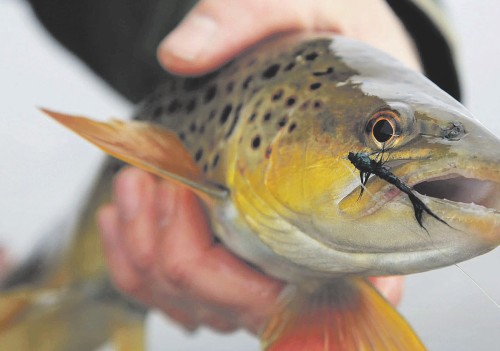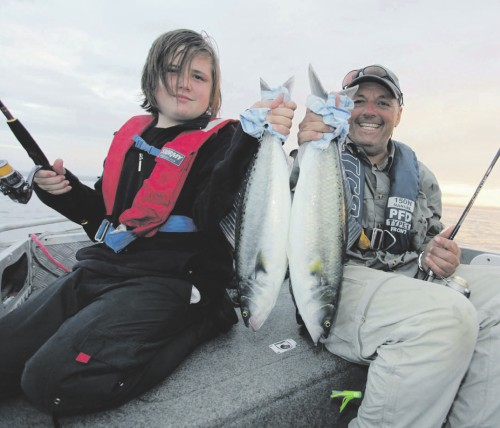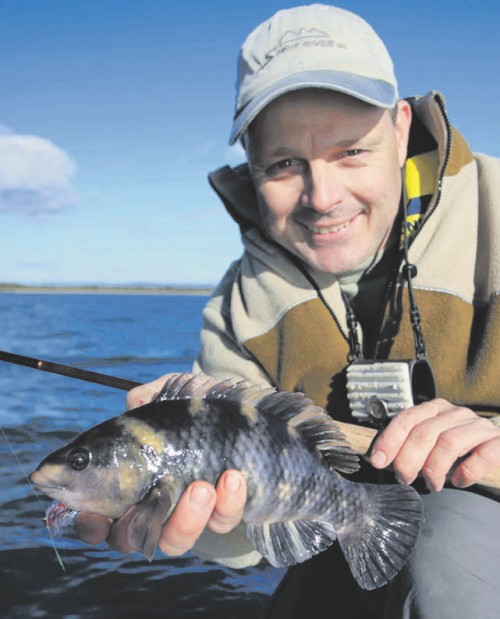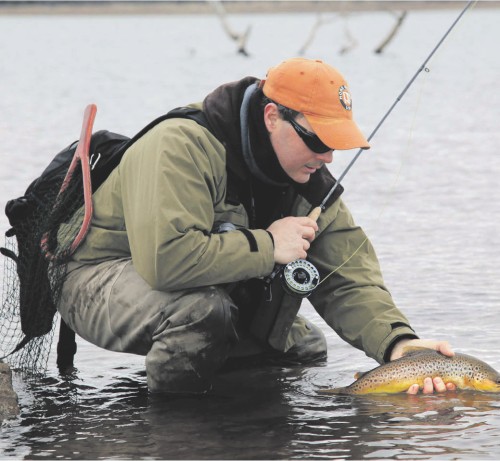 Presented from Issue 116, June 2015
Presented from Issue 116, June 2015
Put some warm clothes on and embrace the world. Winter fishing can be great.
Winter Great Lake
Great Lake is one of a handful of year round trout fishery in Tasmania that offers the die hard trout fisher a place to wet a line in fresh water.
During the months of June and July, the brown trout that have finished spawning are looking to regain condition quickly. The Great Lake Galaxia will be high on their opportunistic diet at this time, making lure and streamer fly fishing a viable option. Shore based fishing is a good bet at this time of year with Browns hunting Galaxia along the rocky shorelines. They also take advantage of the abundance of Stick Caddis over the weed beds and muddy bays. Fur fl ies, Woolly Buggers and streamers are great fl ies to use at this time of year.
A size 10 Montana Nymph with a green or yellow thorax and marabou tail is one of my favorite go to fl ies at this time, because I believe it represents both baitfish and stick caddis in one fly.
If the thought of flogging wets for hours on end is not your thing, then a light weight 2 kg spinning outfit with a handful of small 5 to 6 cm bibbed lures and soft plastics can be a very productive way of catching a few winter Browns and Rainbows. Some good winter shore base locations are Christmas Bay through to the Bee Hives, Swan Bay directly below the pub and Elizabeth Bay along the Western shore, just to name a few. Many other locations around the Lake that have weed beds and rocky shores within a cast, are also worth while.
Fishing a shore with an off shore wind makes casting easier but it’s not always the best place to find the largest concentration of fish. At this time of year it’s often the shore that has the wind blowing into it, that holds the most fish. This is often the case when the wind as been blowing in the same direction for a couple of days as this quickly accumulates those poor swimming aquatic insects such as Stick Caddis, along these shores. The wave action from this wind also hides wading anglers and softens the entry of hard hitting lures or fly lines that might otherwise spook fish in the more sheltered waters. When fishing shores with the wind blowing into them the stress of casting directly into the wind can be eliminated by simply wadding out and casting along and back into the shore . Another way is to fish these shores from the comfort of a boat using an electric outboard or just drifting back into the shore. A boat also gives you the ability to search a lot of water to find more fish.
With that said, shore base fishing during winter can offer surprising results for those who want to brave the cold for the day or just a few hours before retreating to the warmth of the car, shack or pub.
 |
| Australian salmon are great fun and readily available over Winter. |
Winter Australian Salmon
The winter run of Australian Salmon into our estuaries and along the coastline are highly anticipated by anglers and go a long way towards curing the winter blues. The majority of these salmon rarely push up enough bait to attract flocks of birds to give them away, so the run of Salmon could go unnoticed if it wasn’t for word of mouth from keen anglers that have done the hard yards to find them. Sometimes you just have to go looking for them with a sounder or trolling lures in known Salmon destinations around the State to find them. In today’s multimedia world it’s not hard to work out where people are starting to catch Salmon. A good start is the fishing reports from the local news papers, Face book, fishing forums and of course Tas Fishing and Boating News web site to offer some inspiration and somewhere to start.
Salmon are drawn into river mouths and estuaries all around the State. Rivers and their estuaries such as the Duck, Leven, Forth, Mersey, Rubicon and Tamar in the North of the State are well know Salmon haunts during winter. These rivers and the nearby beaches and rocky coastlines are well worth exploring. On the East Coast, Georges Bay always seams to hold a few schools of salmon throughout the year. It’s really hard to say when salmon are going to turn up in any location as they constantly move in and out of an area with the changing weather and tides. One week they will be there in numbers and the next they will be gone. The best times to search an estuary or river mouth with a lures or a sounder is during those low light periods of early morning or late afternoon during the last 2 hours of the incoming and the first 2 hours of the outgoing tide. Trolling is a very effective way to target Salmon, particularly along deep channels and rocky coastlines where fish move up and down the water column with the bait-fish or krill they are feeding on.
Trolling various depths is an easy way to locate these fish, but once you have found them it can often be more beneficial to turn off the outboard and drift or anchor the boat to cast lures or fl ies. This is often the case when the schools of salmon you encounter are in skinny water of 1 to 3 meters. These fish are often spooked out into the deeper water when boats using motorized outboards pass over or near these schools. If you are fortunate enough to be on the water with other boats that have like minded anglers who are willing to drift or anchor when fishing shallow water, the sport had from these fish can be spectacular. Berley such as a frozen block of minced up fish and oil is a great way to hold any passing schools of Salmon close to the boat. With the salmon right at the stern of the boat a very short cast can produce fish after fish. This can be a real winner for kids and those of us who are not used to repetitively casting lures or fl ies to catch these fish.
Casting and trolling lures need only be 5 to 7 cm long. Silver metal lures with a splash of red or blue do well as do hard body bibbed lures with white, green or blue coloration’s. Salmon are well suited to fly fishing and can be targeted using the same fly rod and reel used for trout. A full sinking or sink tip fly line works well when using surf candies, Deceivers and Clousers in all white, white and red, white and yellow and white and olive. A bit of fl ash tied in doesn’t hurt either. Flies are usually cast out and allowed to sink before retrieving them back using a fast erratic strips using a single handed retrieve or a double handed retrieve with the rod tucked under your arm. Small surf fishing poppers trimmed to match the size of the bait fish, make great poppers for salt water fly fishing and work really well on Australian Salmon when you have fish busting through a bait ball at the surface. A fl oating or intermediate line works best on poppers, with a short fast retrieve used to keep them in the water and in the strike zone, like a wounded bait fish. This is exciting fishing and they will even take these tiny poppers dead drift if you can land it among the mayhem.
Wrasse
The humble Wrasse (Parrot fish) and the Blue Throat Wrasse are often regarded as a poor table fish and are sometimes disregarded as a desirable target species. But these fish can be just what you need to liven up a dull Winters day on the water. Parrot Fish have a motility yellowy dark grey colour while a female Blue Throat Wrasse has a brown coloration. The male Blue Throat Wrasse has a more burnt orange and white coloration with striking blue colour under the lower jaw, giving them its name. These fish live close together among the rock and kelp and are quite aggressive and competitive when food is introduced. The bite from these fish can be fast and furious once you have located them on an inshore reef. A simple paternoster rig, baited with some hardy squid or octopus tentacles is all you will need to get in on the action. Once hooked these fish fight hard with a short burst of power to get back into the kelp, but soon tire of this and come quietly to the boat or shore. I have seen them take deep diving lures and soft plastics and they are quite willing to take a small red and white Clouser fly, if you are ever tempted to sink one down into the kelp and tease it back up using short fast strips. They put up a great fight on fly gear and can liven up the day when the Salmon are not playing the game.
 |
| Wrasse - eat them or not? Give Peter Spencer’s recipe a try |
As for being a table fish, well I think we are quite spoiled here in Tasmania and often over look these fish because of the other premier table fish we have in our State. However being able to produce some of the more desirable table fish doesn’t always go to plan. Wrasse on the other hand are much easier to find and catch. I don’t mind the taste and texture of a fresh fillet from a Blue Throat Wrasse that has been bled and skinned. I have served Blue Throat Wrasse up to people without telling them what it was and they often comment on how much they liked the taste of this white fl esh. I have also just discovered a new way of preparing and cooking Wrasse by turning them into fish patties or fish cakes.
The recipe was passed onto me by Peter Spencer who inherited this simple recipe for cooking Wrasse from his father. Using a fish patty recipe to lift the texture and taste of fish such as this makes a lot of sense and definitely turns them into tasty seafood dish that is free of bones and very easy to prepare.
Peter Spencer’s Wrasse Patties
500g of parrot fish or Blue Throat Wrasse
250g of mashed potato
1 egg
1 cup of bread crumbs
1 tbs dried or chopped fresh chives
salt and pepper to taste
1. Remove the scales, head and guts.
2. Boil the Wrasse until the flesh is cooked
3. Remove the fish and peal off the skin. Remove the white meat using a fork to leave the bones on the fish frame.
4. Peal and boil the potato and mash with milk and butter
5. Combined the egg, mashed potato, shredded fish, chives and salt and pepper into a bowl and mix well.
6. Divide mixture into flattish fish patties and coat with dried bread crumbs or flour.
7. Heat oil in a pan and cook until golden brown.
Serve with sweet chili dipping sauce. Garnish with fresh chives or fresh coriander.
This basic recipe can be tweaked to your own taste by adding curries, sweet chilli, fish sauce and garlic. The possibilities are endless for these fish patties.
Craig Rist.

Great Lake is productive all year round.




